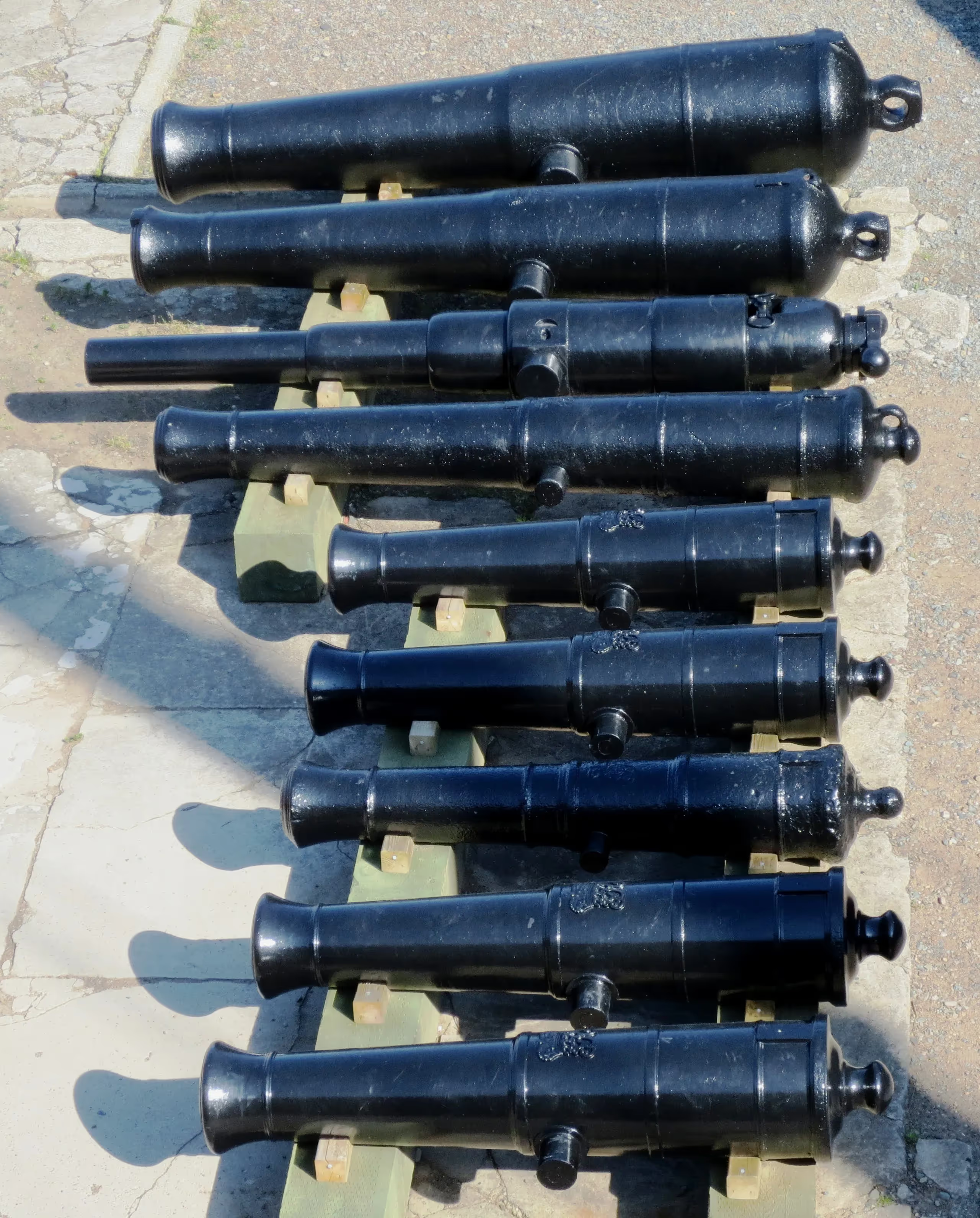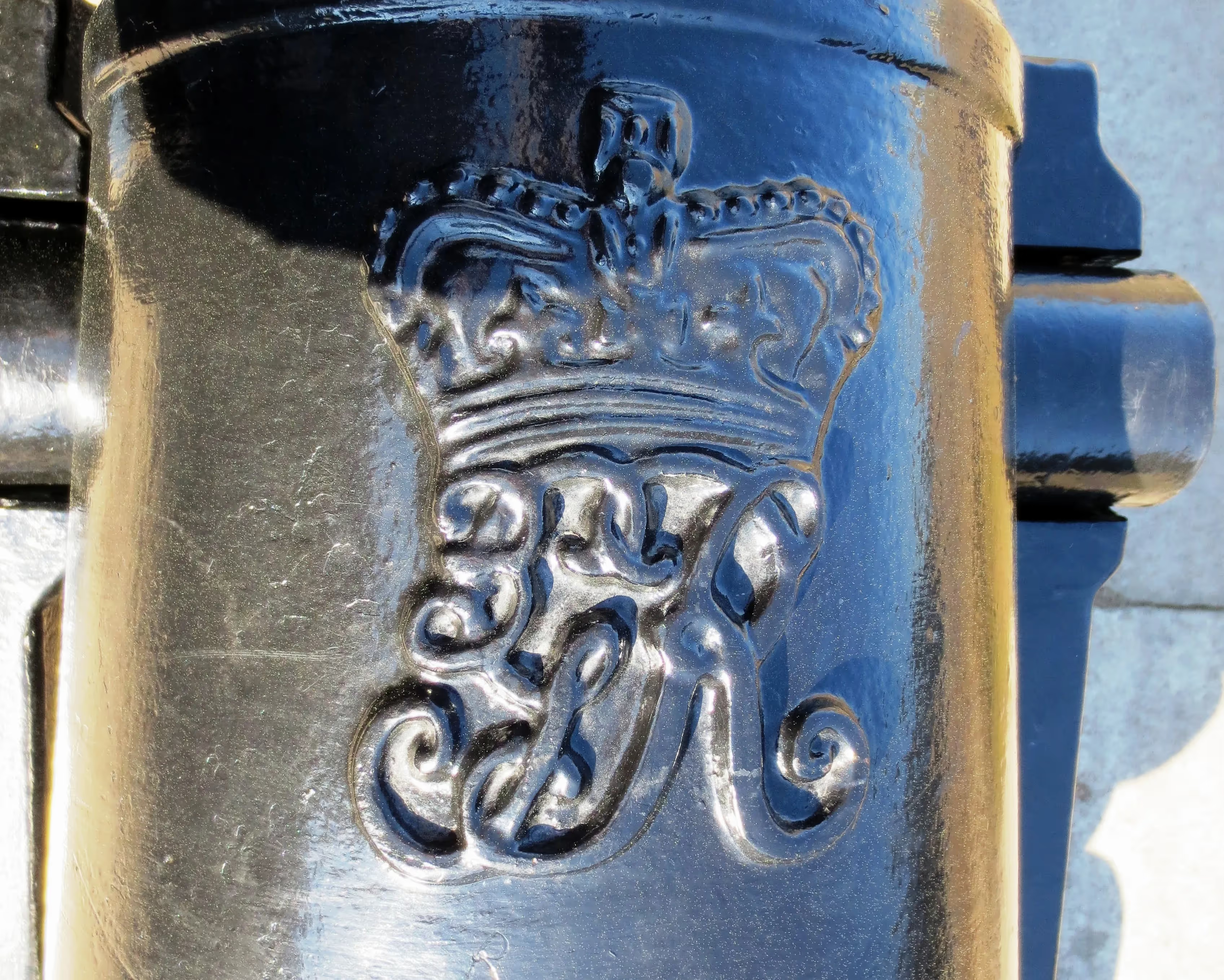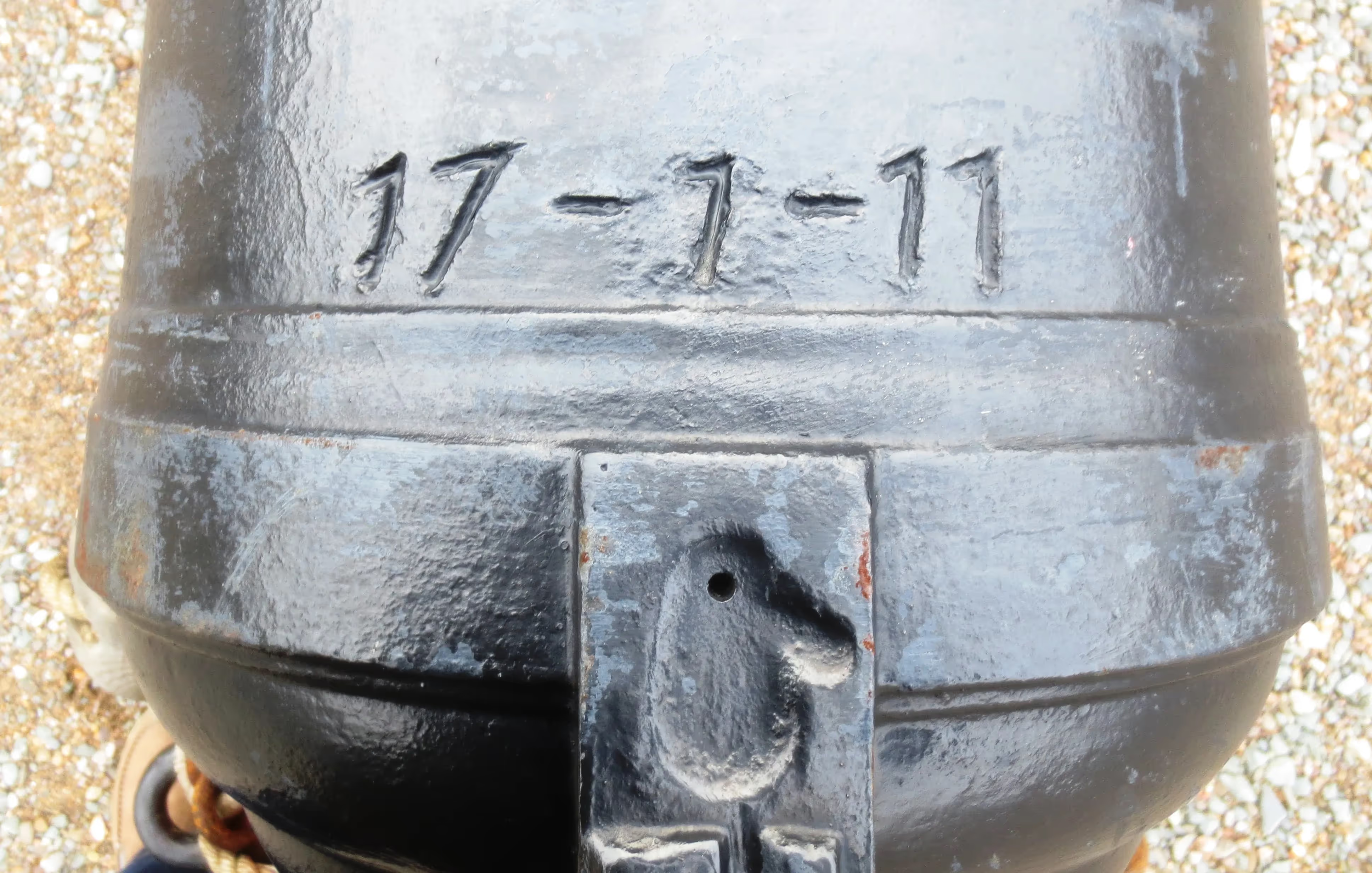Artillery in Canada (9) Nova Scotia: Fort George, the Citadel, Cannon in the Courtyard
Fort George, the Citadel, Cannon in the Courtyard and on the Citadel Parade Square.

(Author Photo)
The gun collection mounted on wood blocks on the Citadel courtyard has varied from year to year. This photo was taken by the author ca. Dec 1973.



(Author Photos)
There are nine guns resting in a row on wood blocks in the courtyard. They are numbered from the rear, right to left, Nos. 1 to 9.
.avif)

(Author Photos)
Courtyard No. 1. Cast Iron 32-pounder 56-cwt Muzzleloading Rifle with Millar-pattern breeching ring, weight possibly 93-1-0 (10,444 lbs), left and right trunnions corroded, Queen Victoria cypher, unmounted.
.avif)

.avif)
(Author Photos)
Courtyard No. 2. Cast Iron 32-pounder 56-cwt Muzzleloading Rifle with Millar-pattern breeching ring, weight corroded (>6,000 lbs), left and right trunnions corroded, possibly (WCo), Queen Victoria cypher. This gun is unmounted, resting on wood blocks.
.avif)
.avif)
.avif)
.avif)
.avif)
.avif)
(Author Photos)
Courtyard No. 3. Armstrong 20-pounder 16-cwt Rifled Breech-loading Gun, weight 16-1-10 (1,802 lbs), (RGF 1867), on the left trunnion. (+) on the right trunnion, Queen Victoria cypher, unmounted.
Twelve Armstrong 20-pounder 16-cwt Rifled Breech-loading Guns, were allocated to the defence of Halifax by the British War Office in January 1873. These guns were likely intended only to be stored in the Halifax Citadel until an attack on Halifax seemed imminent.
.avif)
.avif)
.avif)

Left and Right trunnions.

King George III cypher.

(Author Photos)
Courtyard No. 4. Blomefield Cast Iron 12-pounder Smoothbore Muzzleloading Gun, weight 33---25 (>3,727 lbs), (corroded No. CARRON 1819) on left trunnion, (corroded 12P) on right trunnion, King George III cypher, unmounted.
.avif)

Left and Right trunnions.
(Author Photos)
No. 5. Cast Iron 12-pounder Smoothbore Muzzleloading Gun, no weight visible (>3,000 lbs), (C) on the right trunnion, (16) on the left trunnion, King George III cypher, unmounted replica gun.
In the seventeenth century, Conster furnace at Beckley in Sussex, England, was owned by the Farndon family. In the 1690s William Benge leased it to cast shells for Ireland. Samuel Gott, Farndon's great-grandson, ran the furnace in conjunction with Gloucester furnace in the early eighteenth century. By the 1740s it was included within the Harrison partnership. It went out of use in the 1760-70s. Although Conster furnace was capable of casting large guns, it was often used for the smaller and medium calibres: ½ up to 12 pounders for the government and merchant service. The C is found on the right hand trunnion. This is a rarer mark than those we have looked at earlier and is usually found on smaller calibre guns. Sometimes it can be hard to tell the difference between a damaged G or C. (Ruth Rhynas Brown)

(Author Photo)
No. 6. Cast Iron 12-pounder Smoothbore Muzzleloading Gun, no weight visible (>3,000 lbs), (C) on left trunnion, (16) on right trunnion, King George III cypher, unmounted replica gun.


Left and Right trunnions.
(Author Photos)
No. 7. Cast Iron 12-pounder Smoothbore Muzzleloading Gun, weight 16-3-26 (1,902 lbs), (SOLID) on left trunnion, (B) on right trunnion, very corroded, unmounted. The ‘B’ stands for Bersham, near Wrexham in north Wales, showing that this gun was cast by John Wilkinson at his foundry there. The legend ‘SOLID’ on the trunnion shows that this is a gun bored out of the solid, therefore at the time, both up-to-date and expensive. In fact this gun is a ‘B-SOLID’ product of Bersham. These guns are based on what became known as the ‘Armstrong pattern’ which was introduced into British military service in 1729 and was current up until 1787. The gun can be dated to ca. 1773 (when the ‘B-SOLID’ trunnion mark makes its first appearance) to 1796. The last known reference to Wilkinson supplying guns dates to 1796, when the final guns definitely marked with ‘B-SOLID’ were proofed on 9 -10 May for Wiggins and Graham. These were not guns for government service, as they have no royal badge or any other markings on the barrel, and also they are shorter than the normal government pattern Cast Iron 6-pounder. SBML Gun. Information from the Ordnance Bill Books for the period 1773 - 1796 indicates that standard lengths for government service were 6, 6½ and 7ft, although a few were made in non-standard sizes of 4½ and 8½ft. Guns of this type were cast by gunfounders for the civilian market, usually for smaller merchant ships, coastal communities or landowners who wanted some defence but also wanted something lighter and cheaper than a normal gun. (Dr Brian G. Scott)

(Author Photos)
Courtyard No. 8. Cast Iron 12-pounder Smoothbore Muzzleloading Gun, no weight visible (>3,000 lbs), (C) on left trunnion, (16) on right trunnion, King George III cypher, unmounted replica gun.


Courtyard No. 9. Cast Iron 12-pounder Smoothbore Muzzleloading Gun, no weight visible (>3,000 lbs), (C) on left trunnion, (16) on right trunnion, King George III cypher, unmounted replica gun.

(Author Photo)
Courtyard guns.



Left and Right trunnions.


(Author Photos)
Blomefield Cast Iron 24-pounder 50-cwt Smoothbore Muzzleloading Gun, weight 50-0-12 (5,612 lbs) on the barrel, (1805), on left trunnion, (24P) on the right trunnion, replica gun mounted on an iron garrison carriage, in the courtyard.

(Author Photo)
Gun Gin in the courtyard.




King George III cypher.

(Author Photos)
Blomefield Cast Iron 12-pounder 34-cwt Smoothbore Muzzleloading Gun, weight 34-1-1 (3,837 lbs) below the cascabel, (WCo), Samuel Walker & Company of Rotherham, England on left trunnion, right trunnion corroded, replica gun mounted on an iron garrison carriage, on the parade ground.



Queen Victoria cypher.
(Author Photos)
Cast Iron 7-inch, 7-ton Mk. I Muzzleloading Rifle, weight corroded (>15,000 lbs), left trunnion corroded, (+) on right trunnion, Queen Victoria cypher. This gun is unmounted, resting on wood blocks near the gun gin in the courtyard.





(Author Photos)
Cast Iron 32-pounder 17-cwt Smoothbore Muzzleloading Carronade with a Blomefield pattern breeching ring, weight 17-1-11 (1,943 lbs), mounted on a wood naval gun carriage near the gun gin in the courtyard.

(Author Photo)
Cast Iron 12-pounder Smoothbore Muzzleloading Gun, replica gun, mounted on a wood naval gun carriage. No. 1 of 2.
Cast Iron 12-pounder Smoothbore Muzzleloading Gun, replica gun, mounted on a wood naval gun carriage. No. 2 of 2.
.avif)
.avif)
(Author Photos)
Armstrong 6-pounder 3-cwt Rifled Breech-loading Gun. There should be one of six listed in the "Returns for Halifax" in 1879 (not shown here). Sessional Papers (No. 5), A. 1879, Appendix No. 8. The Return shows the Number of Guns in possession of the Militia and in Dominion Stores at the various places enumerated, exclusive, however, of Guns mounted upon the Fortifications at Halifax, the Reserves maintained by the Imperial Government at that Station and at Esquimalt, and Guns owned by the Hudson Bay Company and by private individuals. Thomas Wily, Director of Stores and Keeper of Militia Properties, and Colonel W. Powell, Adjutant-General of Militia, Ottawa, 27 Dec 1878, p. 276-281.

(Library and Archives Canada Photo, MIKAN No. 4317773)
RCN sailors visiting the Halifax Citadel, 1957.
Cannon on the ramparts of Fort George, the Citadel in Halifax, are listed on a separate page on this website.





